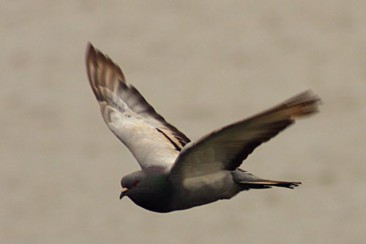David M. Larson

Rock Pigeon. Photograph by Martin Cathrae (CC BY-SA 2.0).
The natural world is a messy place to get around in. Vegetation, rocks, and water bodies are all obstacles if you are flying around low. And then you have to deal with man-made obstructions. Surprisingly, for all we know about bird migration, we know little about short-range navigation in birds and how they deal with obstacles. How does a Cooper’s Hawk blast through a forest at top speed on a hunting run? How do Barn Swallows land on a power line? Do these birds plot their courses far ahead as they fly or do they rapidly adapt to obstacles in their path?
Williams and Biewener (2015) have begun to tease out some of these questions of flight strategy by studying Rock Pigeons (Columba livia) flying along a corridor from one perch, through an array of vertical posts, to another perch. Distances between the posts were adjusted from 13–26 centimeters (5.1–10.2 inches), corresponding to 20–40% of the birds’ wingspans. The pigeons successfully traversed the barrier of posts in more than 95% of attempts, although adjusting the gaps to less than 13 centimeters greatly increased refusals by the birds. Flight dynamics were recorded with high-speed digital video as the birds flew through the barriers. In order to analyze flight parameters from the recordings, small infrared light-emitting diodes powered by a harness battery pack were affixed to the birds on the head, back, and at two places on each wing (near the tip and at the wrist). These light sources, undetectable by the birds but clearly detectable on the video recordings, provided spatial information for computerized analysis of the videos.
The authors also monitored approach speed of the birds and found that they flew more slowly when approaching smaller gaps, suggesting that the birds were more cautious. Apparently they take more time to assess their response to tighter flight restrictions.
While one might suspect that the birds would adopt a variety of responses to the challenge of flying past these vertical posts, in fact the authors found two stereotypical postures: “folded”—wings folded up and in, similar to a non-flying wing posture, and “paused”—wings lifted and paused at the top of the flight upstroke. The predominant wing posture for narrow gaps was with the wings folded, but when the gaps were wider, birds often used the paused posture. The paused posture has the advantage of less interruption of the normal wingbeat, a quicker return to normal flight dynamics, and less loss of height during passage through the barrier. The more complicated folded response resulted in longer disruption of normal wingbeat and more loss of altitude during traversal. Interestingly, there was little difference in the width of the profile of the birds in the two postures.
Since the paused posture is more efficient, why do the birds switch from paused to folded postures when confronted with narrower gaps? Minor collisions with posts were more common when the gaps were smaller, some due to minor miscalculations during last-second flight corrections to aim for the midpoint between posts. Mathematical modeling of the effects of brushing the posts during traversal suggests a benefit of the folded wing response in passing through small gaps—the minor collisions apparently produce smaller perturbations in the aerodynamics of the bird than in the paused response. This discrepancy could be due to the collision being closer to the center axis of the bird in the folded posture and effects being magnified when the collision is at the wing tips in paused posture.
It appears that these birds are able to detect the relative gap size between vertical posts, adjust their flight path toward the centerline between the posts, abort if the gap is too narrow, and adopt one of two wing posture responses based on the size of the gap. While the paused posture is more efficient in terms of shorter interruption of normal flight and less loss of height, the folded posture is desirable in the case of accidental contact. Hence, the birds traversing narrower gaps used a folded wing posture, trading flight efficiency for stability in case of collision.
Reference
- Williams, C. D., and A. A. Biewener. 2015. Pigeons trade efficiency for stability in response to level of challenge during confined flight. Proceedings of the National Academy of Sciences of the U.S.A. 112(11): 3392-6.
David M. Larson, PhD, is the Science and Education Coordinator at Mass Audubon’s Joppa Flats Education Center in Newburyport, the Director of Mass Audubon’s Birder’s Certificate Program and the Certificate Program in Bird Ecology (a course for naturalist guides in Belize), a domestic and international tour leader, Vice President of the Nuttall Ornithological Club, and a member of the editorial staff of Bird Observer.